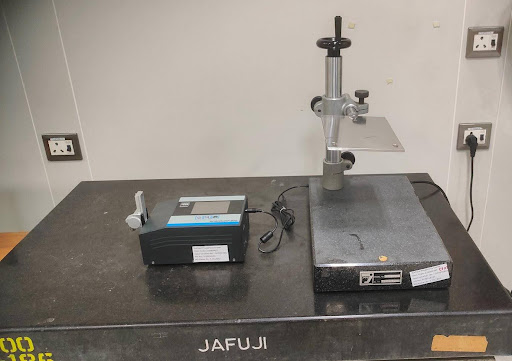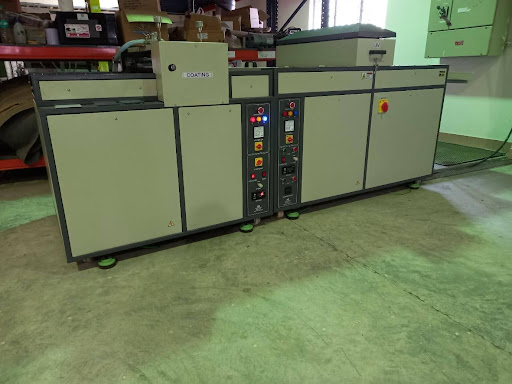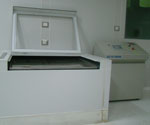Centre for Sol-Gel Coatings (CSOL)
Clean Room Facility
Details
A Class 10000 clean room of area 130 m2 has been set up for carrying out coating, curing and drying processes in a highly controlled environment when the applications demands so. A Class 1000 clean area of 8 m2 has been set up inside the Class 10000 clean room for even more critical coating operations.
Specifications
Curing and Densification
The following units have been set-up for drying, curing and densification of coatings:
- Dense ceramic bodies
- Coatings/thin films
- Aerogels
- Monoliths and
- Ceramic fibres
Centre
Centre for Sol-Gel Coatings
Coating Equipment
Flat spray unit
A spraying unit for flat substrates of varying dimensions up to 600 mm x 600 mm is available at the Centre. The sample table has a maximum displacement of 2000 mm. A variety of coating parameters, such as the transverse and lateral speeds of the spraying nozzles along with the table speed can be controlled to obtain coatings of desired quality. The unit is attached to a drying oven for baking the coatings prepared.
Spray coating line
A chain type coating line equipped with 95 spindles for coating of symmetrical components has been installed and commissioned. The unit is capable of coating up to 900 components per hour and the conveyor speed can vary from 1 to 15 parts per min. The coated components can be heated / dried in an adjoining IR chamber. The dimensions of a typical component that can be handled are 200 mm height and 150 mm diameter.
Spin coater
Two desk top spin coating units are available for carrying out experiments at the lab scale. The largest sample that can be handled for spin coating would be a wafer of dimensions 200 mm x 200 mm.
Dip coater
A table-top dip coater, is available for carrying out lab-scale experiments on 100 mm square substrates of up to 5 mm thickness. Variable withdrawal speed allows control over film characteristics such as thickness and uniformity. Angle dependant dip coater-can take up 1 m x 1 m substrates and can be tilted up to an angle of 15 degrees.
Cross Hatch Cutter
Details
Used to analyze the adhesion of simple and multilayer coatings on substrates, as well as between multilayer coatings according to ASTM D 3359. The cross hatch cutter or the cutting tool, has one to six special blades with a separation of 1 or 2 mm, is scanned on the coatings to form a grid. A 75 mm length of a 25 mm wide semitransparent pressure sensitive tape is placed with its centre on the grid such that no creases are formed so as to ensure good contact between the surfaces. The tape is removed within 90 ± 30 seconds of application by seizing the free end and rapidly pulled back upon itself without jerks at as close an angle of 180o as possible. The grid area is inspected for the removal of coating from the substrate.
Centre
Centre for Sol-Gel Coatings
Hazemeter
Specifications
- System sample port - 21 mm
- Measurement area - 16.5 mm
- Measurement ranges of haze and transmittance are 0-100% with a measurement time from 0-6 sec.
Details
Used for measurement of Haze and transmittance of coatings on transparent substrates. According to ASTM 1003, haze is the percentage of light that deviates from the incident beam by more than 2.5o on average. Particles or surface irregularities like scratches act as light scatterers and results in a hazy appearance of the material. Mainly, the unit is being used for evaluation of Haze and transmittance of transparent coatings on transparent substrates like glass or plastics.
Centre
Centre for Sol-Gel Coatings
IR - Curing System
Model & Make
Oven type Near Infra Red (NIR) Curing System, Advance Curing Systems (ACS), Bangalore
Specifications
- Heating source : Near Infrared Lamps
- Number of lamps : 6 Nos
- Power : 27 kW
- Heating area : 250 mm x 120 mm
- Temperature control : Thyristor with PLC
- Max Temperature : 350oC
Details
The absorption of NIR radiation by organic molecules leads to molecular vibrations that generates the heat by the material itself. This phenomenon has various applications such as in drying, evaporation, gelling and hardening etc. of coatings/materials. Use of IR radiation for curing of coatings has the advantage of efficiency, energy saving and better performance when compared to conventional curing method. The available NIR curing facility has IR emitters with gold reflector so as to utilize 95% of the available radiation to cure the work piece surface.
Centre
Centre for Sol-Gel Coatings
Pilot Plant for the Large Scale Synthesis of Sols
Details
A pilot plant for the synthesis of inorganic and organic-inorganic hybrid sols has been set up. It consists of three reactors of capacities 100 l, 20 l and 10 l with storage vessels of various capacities (from 30 l up to 200 l) attached to the respective reactors. Known quantities of the precursors or reactants can be transferred from the storage vessels into the reactors. Small additions of chemicals can be precisely controlled through suitable dosing systems, provided. The reactors can be operated in the temperature range -5oC to 150oC. The plant is equipped with sophisticated process controls and safety mechanisms for efficiently producing large volumes of sols. The prepared sols can be collected in receivers and transported for coating, curing and densification.Centre
Centre for Sol-Gel Coatings
Portable hand held Emissometer
Model & Make
AE 1, Devices & Services Company, Texas, USA
Specifications
- Measurement area : 0.75" (in flat samples); 1.0" (in tube samples)
Details
The portable emissometer measures the thermal emissivity of a material/coating. Thermal emittance measurements with the emissometer require that the high and low emittance standards and the sample to be measured be maintained at the same temperature. To achieve a uniform temperature, the instrument is provided with a heat sink on which the standards as well as the sample (normally flat) is to be mounted. Appropriate adapters can be used to measure the emittance of curved profiles also. The accuracy or repeatability of the instrument at room temperature for any particular measurement is high.
Centre
Centre for Sol-Gel Coatings
Portable Surface Roughness Tester
Details
TESA- rugosurf 90G is a portable surface roughness tester having the distinctive properties required for use in a laboratory to measure surface roughness parameters according to the following standards.
ISO 4287:1997, JIS B0601:2001, ASME B46-2002, ISO13565, JIS B0671, DIN and ISO 12085:1998 JIS B0631:2000
Adjustable measuring parameters of instrument:
- Cut off length : 0, 08-0, 25-0,8-2, 5-8 mm
- Number of cut offs : 1 to 19 or 1 to 5 for a 8 mm cut off length
- Probing speed : 0.5 or 1 mm/sec.
This is used to measure the surface roughness of both uncoated and coated samples for optimisation of surface roughness parameters.
- Cut off length : 0, 08-0, 25-0,8-2, 5-8 mm
- Number of cut offs : 1 to 19 or 1 to 5 for a 8 mm cut off length
- Probing speed : 0.5 or 1 mm/sec.
This is used to measure the surface roughness of both uncoated and coated samples for optimisation of surface roughness parameters.
Centre
Centre for Sol-Gel Coatings
Roller Coating Unit with UV Curing Facility
Details
Roller coating unit to deposit sol-gel coatings on flat substrates with varying thickness from 0.5 mm to 10 mm, 300 mm width and 500 mm length dimensions is available at the Centre. The conveyorized unit has an inline UV curing facility to instantly polymerise and bake the coatings. The conveyor speed can be altered in the range of 0 m/sec to 10 m/sec to optimise the coating thickness that shall change as a function of sol viscosity. Metals, ceramics, plastics, paper and wooden substrates can be coated on one surface using the machine.
Centre
Centre for Sol-Gel Coatings
Scratch Hardness Tester
Details
Used for evaluating the scratch resistance of coatings. Pencil hardness test is an easy and fast method to determine the scratch hardness of coatings on substrates by means of drawing pencil leads of known hardness varying from 9H to 9B at a constant applied mass across the coated surface and is measured according to ASTM norm D 3363-05. The testing unit comprises the body which is the pencil tester, a set of 20 pencils of varying hardness and a special pencil sharpener.
Centre
Centre for Sol-Gel Coatings
Substrate Cleaning/Pretreatment Facilities
Details
To obtain high quality coatings, high quality substrates that are prepared and cleaned well are the most essential requirements. Presence of dust or grease can adversely affect the uniformity of coatings and their adhesion to the substrates. Defects once introduced during the coating stage are seldom removed by post treatment techniques like curing or annealing. In view of this, the Centre for Sol-Gel Coatings has procured state-of-the-art cleaning equipment suitable for a variety of substrates. EPG, based on prior experience, had made recommendations for upgraded versions of some of the equipment, making this facility at ARCI better than the one at EPG's location at Saarbrucken, Germany.
The cleaning facilities established at the Centre are the following:
Flat glass cleaner
A flat glass cleaner is available for cleaning of glass substrates of varying dimensions. The equipment has a working width of 1300 mm. Typically, the substrate size can vary from 1000 mm long and 1000 mm wide to 300 m long and 250 mm wide. The thickness can be between 1-8 mm and the conveyor speed can be varied from 2-5 m/min. The machine uses demineralized water for cleaning.
Pre-treatment System
Sword Brush Cleaner
This is for cleaning glass, metal or plastic substrates by removal of the fine layer of dust that forms on substrates. The machine can handle substrates with maximum dimensions 1500 mm in length and 1500 mm in width. Minimum dimensions that can be handled are 250 mm x 250 mm and thickness can vary between 2 mm and 50 mm. The conveyor speed can be from 2-7 m/min.
Flat spray unit
Plasma Pre-treatment System
A fully programmable plasma pretreatment unit has been set up for activation of the substrate surfaces. The manipulation of substrate position and substrate handling is made possible by a 6-axis robot. Depending on the nature of the substrate and coating, this technique can be used to improve the adhesion properties of the coating on the substrate. The plasma temperature is approximately 300oC and the substrates can be glasses, metals or plastics. Samples can range from 100-300 mm in length and 100-300 mm in width, depending on the nature and mass of the substrate. Working distance can be varied between 6 and 20 mm.
Ultrasonic Cleaners
Ultrasonic cleaners of capacities 110 and 210 litres have been installed for removal of grease and accumulated dust on the surface of the substrates. Maximum weight of the substrates for the two units are 20 and 40 kg, respectively.
Centre
Centre for Sol-Gel Coatings
Taber Abrasion Tester
Model & Make
Taber Dual Rotary Platform Abrasion Tester model 5155
Specifications
- Abrading wheels- CS-10 calibrase wheels
- Operating loads : either 250 or 500 g
- Speed of the wheels: between 60 and 72 cycles/minute
Details
Used for measuring the abrasion resistance of prepared coatings according to ASTM norm D 4060 - 01. The abrading wheels are resilient wheels that offer a mild-medium abrading action like that of normal handling, cleaning, and polishing. The wheels are refaced periodically with a refacing disc. The abrasion resistance of the coating is quantified by periodically measuring the mass (volume) loss of the coatings or determined qualitatively by the visual end point method.
Centre
Centre for Sol-Gel Coatings
Thin Film Analyzer
Model & Make
F20, Filmetrics Inc., USA
Specifications
- Thickness range : 15 nm to 50 µm
- Accuracy : 1 nm
- Precision : 0.1 nm
- Stability : 0.07 nm
- Wavelength : 400 to 1000 nm
Details:
The thin film analyzer works based on the intensity measurement of reflecting and transmitting light through the sample. Hence, thickness of only transparent coatings can be measured, though the substrates can be of transparent or non-transparent nature. There are possibilities of using a contact or a non-contact probe depending upon the nature of film and the substrate.
Centre:
Centre for Sol-Gel Coatings
UV - Curing system
Model & Make
Conveyorised 3 Lamp UV Curing System, Advance Curing Systems, Bangalore
Specifications
- Light source : Medium Pressure Hg Quartz Lamps
- Power : 300 W/inches (each lamp)
- Curing width : 1000 mm (Max)
- Belt speed : 0.5 to 15 m/min
- Component Height : 25 mm
- Cooling : Centrifugal Blowers
- Mode : Auto and manual
Details
The main advantage of use of organic-inorganic hybrid coating systems is the use of low temperature radiation assisted curing for densification of coatings. The importance of ultraviolet (UV) curing especially realized when functional coatings like scratch resistant coatings, antireflective coatings etc. need to be cured on temperature sensitive transparent plastic substrates like polymethylmethacrylate (PMMA) and polycarbonate (PC). The unit is conveyorised having three lamps emitting UV radiation. The power of each UV lamp can be controlled individually. The centrifugal blowers attached to each lamp help to cool the substrate and remove the volatile organic by-products upon UV irradiation. A part of the equipment (substrate feed in) is placed inside the clean room and the lamps along with the hoods are placed outside the clean room. The conveyor belt is capable of an automated reverse motion, so that once curing has been completed during the forward motion of the belt, the cured substrate is brought back into the clean room due to the reverse motion of the conveyor belt.
Centre
Centre for Sol-Gel Coatings
UV-Vis NIR Spectrometer
Specifications
- Wavelength : 200 to 3600 nm (300 to 2400 nm for integrating sphere)
- Make and model: Shimadzu, Japan UV-3600 Plus
Details
UV/Vis spectroscopy is mainly used in quantitative analysis in analytical chemistry. In the field of material science predominantly used to study the optical properties of materials, such as absorption, transmittance and reflectance of the developing material. Some extend it is used to estimate the energy band gap of semi-conductors. The samples can be finely divided powders, low concentration solutions and solids or thin films.
Contact person – Dr K Murugan, murugan@arci.res.in
Centre
Centre for Sol-Gel Coatings
Viscometer
Model & Make
ViscoLab 4100, Cambridge Applied Systems, Inc
Specifications
- Viscosity : 0.2 to 10,000 centipoise
- Minimum sample required : less than 2 ml of fluid
- Operation temperature : -40 - 90oC
- pH of the fluid : 2.5 - 11
- Time required per sample: 30 minutes
Details
The vibrational viscometer, has been used to study rheological behaviour of ceramic powder suspensions. The principle of measurement of viscosity in a vibrational viscometer is based on damping of an oscillating electromechanical resonator immersed in a fluid whose viscosity is to be determined.
Centre
Centre for Sol-gel Coatings
Weathering Resistance Measurement System
Model & Make
Xenon test chamber model XE-3-HBS, Q-Lab Corporation, USA
Specifications
- Number of xenon lamps: 3
- Possible temperature range of test chamber: 25-110oC
- Range of relative humidity control : 10-95%
- Appropriate filters available for simulation of solar radiation behind window glass as well as for outdoor solar radiation
Details
The xenon test chamber is a laboratory testing facility to evaluate the product durability for indoor as well as outdoor conditions by exposing the product to simulated weather conditions. This accelerated testing facility has mostly been used in development and durability evaluation of paints/coatings for corrosion protection, anti-reflective, anti-tarnishing application as well as in the evaluation of the UV/weather resistance of polymer products/coatings.. The Q-SUN tester's user interÂface is designed to be functional, highly reliable and easy to use. Xenon arc lamps produce the most realistic reproduction of the full specÂtrum of solar radiation. The humidity and temperature corresponding to varying weather conditions can also be simulated accurately.
Centre
Centre for Sol-Gel Coatings



5.jpg)

1.jpg)









